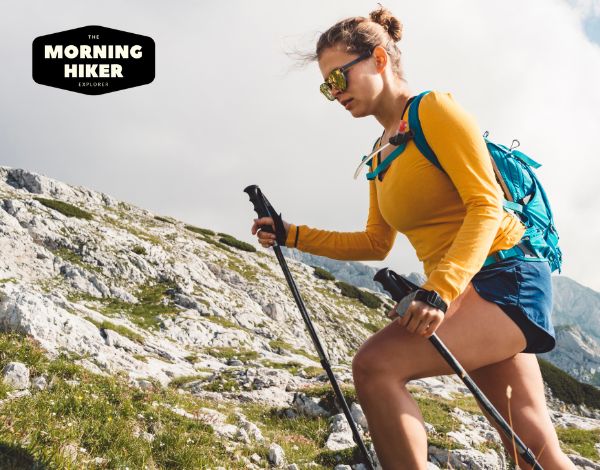Discover the surprising health benefits of hiking. Is it an aerobic or anaerobic activity? Find out now!
This post contains some affiliate links to products that I use and love. If you click through and make a purchase, I’ll earn a commission, at no additional cost to you. Read my full disclosure here.
You may think of hiking as just a leisurely activity, but did you know that it can also be a great workout? Some people may shy away from hiking because they believe it to be too difficult or strenuous.
However, uncovering the hidden benefits of hiking and understanding whether it is an aerobic or anaerobic exercise can help you make informed decisions about your fitness routine.
If you’re looking for a way to get outside and enjoy nature while also getting some exercise, then hiking might just be the perfect solution.
Not only does hiking offer physical benefits, such as improving cardiovascular health and building strength in your legs and core, but it also provides mental benefits like reducing stress and boosting mood.
But how does hiking compare to other forms of exercise? Is it more aerobic or anaerobic? Understanding this distinction can help you tailor your workouts to achieve specific goals.
So let’s dive in and explore the hidden benefits of hiking!
In This Article
The Physical Demands of Hiking
The physical demands of hitting the trails can take a toll on your body, but don’t let that scare you away from this rewarding activity. Hiking is an excellent way to stay fit while enjoying nature and exploring new destinations.
However, before embarking on a hike, it’s crucial to consider trail difficulty and ensure you have proper gear for the terrain.
Depending on the trail’s length and elevation gain, hiking can be both aerobic and anaerobic exercise. Uphill climbs require more effort from your muscles and lungs, making them anaerobic; while flat or downhill sections are less demanding and tend to be aerobic.
Investing in quality hiking shoes with good grip, moisture-wicking clothing appropriate for the weather conditions, and carrying enough water will make your hikes more comfortable.
Now that we’ve covered the physical aspects of hiking let’s explore its mental benefits.
Mental Benefits of Hiking
Get ready to boost your mood and clear your mind with mindful hiking. Hiking isn’t just about physical fitness, but also about mental health. Nature therapy has been proven to be an effective way to reduce anxiety and depression, as well as improve overall psychological well-being.
When you’re out in nature, the sights, smells, and sounds can help you focus on the present moment and forget about any worries or stressors.
Mindful hiking is a form of meditation that involves being fully present in the moment while walking in nature. This type of hiking encourages you to pay attention to your surroundings with all five senses.
The calmness that comes from this experience can help reduce stress levels and increase feelings of happiness and contentment.
So next time you hit the trails, take a moment to appreciate all that nature has to offer and practice mindful hiking for some added mental benefits.
As important as it is to focus on the mental benefits of hiking, it’s also essential to understand how it affects our bodies physically.
Let’s explore the difference between aerobic vs anaerobic exercise and how these types of exercise are related to hiking.
Aerobic vs. Anaerobic Exercise
Exploring the difference between aerobic and anaerobic exercise can help us understand how hiking affects our physical health.
Aerobic exercise involves low to moderate intensity activities that require oxygen to produce energy, such as brisk walking or jogging. It helps improve cardiovascular health, endurance, and overall fitness levels.
On the other hand, anaerobic exercise involves high-intensity activities that do not rely on oxygen but rather use stored energy in muscles for short bursts of power, such as weightlifting or sprinting. It helps build strength, power, and speed.
Hiking falls under the category of aerobic exercise as it requires sustained effort over a longer period while maintaining a steady pace. One of the key benefits of hiking is improved cardiovascular health due to increased heart rate and blood circulation throughout the body.
It can also help with weight loss and management as well as reducing stress levels by being surrounded by nature. However, there are also some drawbacks to consider when incorporating hiking into your training strategies such as potential injuries from uneven terrain or overexertion if not properly prepared beforehand.
As you reflect on these benefits and drawbacks of hiking for aerobic exercise, you may be wondering about other ways hiking can contribute to your overall physical health.
The next section will delve into more detail about the various health benefits of hiking beyond just its impact on our cardiovascular system.
Health Benefits of Hiking
If you’re looking for a way to improve your cardiovascular health, increase your strength and endurance, or manage your weight, hiking might just be the perfect activity for you.
With its varied terrain and natural beauty, hiking provides both physical and mental benefits that can help you reach your fitness goals.
So whether you’re a seasoned hiker or just starting out, hitting the trails could be exactly what you need to boost your overall health and wellness.
Improved Cardiovascular Health
Regular hiking can improve your cardiovascular health by increasing your heart rate and strengthening your heart muscle. As you hike up a trail, your heart pumps faster to deliver oxygen to your muscles, which increases blood flow and strengthens the heart muscle over time.
This increased cardiovascular endurance can lead to a variety of health benefits, including reduced risk of heart disease, lower blood pressure, and improved overall fitness. Imagine feeling confident in your ability to climb a steep hill without getting winded.
Picture the satisfaction of completing a long hike without feeling exhausted. Think about how exhilarating it would be to feel energized after a challenging hike rather than drained.
By incorporating regular hiking into your exercise routine, you can experience these emotional responses while improving your cardiovascular health at the same time. So why not hit the trails and reap the benefits?
Hiking also offers increased strength and endurance – let’s explore that next!
Increased Strength and Endurance
Get ready to boost your strength and endurance while hitting the trails – did you know that hiking can burn up to 400 calories per hour?
As you hike, your body works hard to climb hills, navigate rough terrain, and carry a backpack. All of these movements require resistance training for your muscles to adapt and grow stronger. By engaging in hiking regularly, you’re building muscle mass, which improves your overall strength and stamina.
But don’t forget the importance of proper nutrition for endurance during hiking. Eating a balanced diet with enough protein, carbohydrates, and healthy fats will help fuel your body for those long hikes. Proper hydration is also crucial for maintaining endurance levels.
- 【Health Metrics Monitoring】These fitness watches for women and men pack 24/7 heart rate, blood oxygen, blood pressure monitors and sleep tracker. You could check those real-time health metrics…
- Heart Rate Monitoring and SpO2: Our smart watch monitors your heart rate in real time, and you can use the watch to manually detect your SpO2. Our smartwatch will also automatically track your sleep,…
- Heart Rate and Sleep Monitoring: The Fitness Tracker monitors your heart rate automatically all day, and you can select manual mode through the App. The fitness Watch also monitors your sleep at…
- 【Superb Visual and Operational Experience】The unique curved 1.47-inch ultra-HD full touch screen of this fitness tracker offers you superb visual and operational experience. Immerse yourself in…
When you combine proper nutrition with regular hiking sessions, not only will you see an increase in physical ability, but also improved mental health due to the release of endorphins during exercise. So lace up your boots and hit the trails because there’s no better way to improve strength, endurance, and overall wellness than through hiking.
As you work on building your strength and endurance through hiking, another benefit that can come from this aerobic activity is weight loss and management.
By burning those extra calories through consistent physical activity like hiking along with being mindful of what you eat both on and off the trail, you can lead to successful weight loss or maintenance goals.
Weight Loss and Management
You can enhance your overall physical wellness by incorporating hiking into your weight loss or management plan.
It helps burn calories and promotes healthy eating habits. Hiking is an aerobic activity that requires a significant amount of energy expenditure, making it an effective way to burn calories. Depending on factors such as body weight, pace, terrain, and pack weight, hikers can expect to burn between 400-700 calories per hour.
This caloric expenditure can contribute to weight loss or maintenance when combined with a balanced diet. In addition to burning calories, hiking also promotes healthy eating habits through increased awareness of nutrition and hydration strategies. When planning a hike, it’s essential to bring nutritious snacks and plenty of water to stay hydrated.
Trail mix with nuts and dried fruit provides sustained energy without weighing down your pack.
Drinking enough water throughout the hike will keep you from feeling sluggish and reduce the risk of dehydration-related health issues. By incorporating hiking into your weight loss or management plan, you’ll not only burn calories but also learn healthy habits that can contribute to long-term wellness.
As you continue exploring the benefits of hiking for physical wellness purposes like calorie-burning and nutrition awareness, there are specific tips to get more out of every hike experience.
Tips for Getting the Most Out of Your Hiking Experience
If you’re looking to maximize your time on the trails, these tips will help boost your hiking experience. Did you know that hikers burn an average of 400-700 calories per hour?
To get the most out of your hike, it’s important to prepare beforehand. Make sure you have the right gear and clothing for the terrain and weather conditions. Wear comfortable shoes with good traction and bring plenty of water and snacks.
Before hitting the trail, take some time to stretch and warm up your muscles. This can help prevent injuries and improve your overall performance.
As you hike, pay attention to trail safety by staying on designated paths, watching out for wildlife, and being aware of any potential hazards like loose rocks or steep drop-offs.
By following these tips, you’ll be able to fully enjoy all the benefits that hiking has to offer – from improved physical fitness to a greater sense of mental clarity and connection with nature.
- Removes Bacteria & Parasites: The Microfiltration Membrane Removes 99.999999% Of Waterborne Bacteria (Including E. Coli And Salmonella), And 99.999% Of Waterborne Parasites (Including Giardia And Cryptosporidium)
- Stay cool, fresh and comfortable all day with our lightweight, breathable, water-resistant and quick-dry women’s hiking pants.
- BUILT TO LAST: Whether you’re hiking on rugged terrain or the beaten path, you need hiking gear that can keep up! Trailbuddy trekking poles are built tough enough for the long haul.
- Security And Reliability – All of our first aid products carry certificate of conformity to ensure conformance to global standards wherever they are used.
Frequently Asked Questions
What are some common hiking injuries and how can they be prevented?
As you prepare for your next hiking adventure, it’s important to take preventive measures to avoid injury.
Some common hiking injuries include twisted ankles, blisters, and sunburns. To prevent these injuries, make sure you have the essential gear for hiking such as proper footwear with ankle support, blister prevention products like moleskin or tape, and sunscreen.
It’s important to warm up before hitting the trail and take breaks throughout your hike to rest and hydrate. By taking these precautions, you can enjoy a safe and injury-free trek through nature.
How does hiking compare to other forms of exercise in terms of calorie-burning?
When it comes to calorie burning comparison, hiking can be a great option for those who want to get fit while enjoying the outdoors.
In fact, hiking burns more calories per hour than walking or jogging on flat ground, and can even rival running when you go uphill.
The benefits of hiking for cardiovascular health are also worth noting – as you climb up hills and mountains, your heart rate increases and your lungs work harder to supply oxygen to your body.
Plus, being out in nature can reduce stress levels and improve mood. So if you’re looking for an enjoyable way to burn calories while improving your overall health, consider hitting the trails instead of the gym.
Are there any age restrictions or limitations for hiking?
As a senior, you may be wondering if hiking is still a safe and enjoyable activity for you. The good news is that there are many benefits of hiking for seniors, both physical and mental.
Hiking can improve balance, flexibility, and cardiovascular health while also providing opportunities to socialize and enjoy nature. It’s important to choose the right difficulty level for your abilities and pace yourself accordingly.
Some trails may have steeper inclines or rougher terrain than others, so it’s always best to research beforehand or ask for recommendations from experienced hikers. With proper preparation and precautions, hiking can be a fulfilling way to stay active and connected with the outdoors as you age.
How does the terrain affect the physical demands of hiking?
Imagine you’re out on a hiking trail, surrounded by lush greenery and stunning views. As you navigate through different terrains, from steep inclines to rocky descents, your body is constantly being challenged in unique ways.
These terrain challenges not only make for an exciting adventure but also activate different muscles throughout your body. Uphill climbs engage your glutes and quads while downhill descents work your core and lower leg muscles.
Hiking on uneven surfaces also activates smaller stabilizing muscles that may not get used as much during other forms of exercise.
So, next time you hit the trails, embrace the variety of terrains and appreciate how they’re contributing to a full-body workout!
What are some safety precautions to take when hiking alone?
When hiking alone, it’s important to take safety measures to ensure your well-being.
Before heading out, make sure you inform someone of your plans and expected return time.
Bring a fully charged cell phone and a map or compass in case you get lost.
Additionally, pack enough food and water for the duration of your hike and wear appropriate clothing for the weather conditions.
In case of an emergency response, know basic first aid skills and carry a whistle to signal for help if needed.
By being prepared and taking these precautions, you can enjoy the freedom of solo hiking while staying safe on the trails.
Before You Go
Congratulations! You’ve learned about the physical and mental demands of hiking, as well as the difference between aerobic and anaerobic exercise.
Now, let’s take a moment to reflect on the health benefits of hiking. Hiking is not only a great way to stay fit, but it also has many positive effects on your mental wellbeing. Being surrounded by nature can help reduce stress levels and promote mindfulness.
Additionally, hiking can strengthen bones, improve heart health, and boost your immune system. In conclusion, hiking is more than just a physical activity; it’s an opportunity to connect with nature and improve both your body and mind.
As John Muir once said, “In every walk with nature one receives far more than he seeks.” So go out there and explore the wilderness; you never know what hidden benefits you may uncover along the way!
Survival MD

Exclusive Report Reveals The Most Comprehensive Guide To Survival Medicine
- What to do when there is no doctor available
- How to make it without electricity
- Reattach a tooth using salt water
- How to improvise a splint from a plank, pillow, or rolled-up newspaper
- Safely dress a burn in food wrap or a plastic bag
- Powerful proven-to-work home remedies
- Water filtration basics
- How to make your own antiseptic and sanitizer
- And much more…











We are participants in the Amazon Services LLC Associates Program, an affiliate advertising program designed to provide a means for sites to earn advertising fees by advertising and linking to Amazon.com